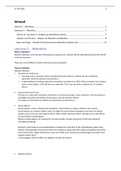Inhoud
Lecture 5 – Attention..............................................................................................................................1
Summary 5 – Attention...........................................................................................................................7
Awh et al. Top-down vs. bottom up attentional control.....................................................................7
Johnson and Proctor – Chapter 12 Disorders of attention..................................................................8
Baars and Cage – Chapter 8 Consciousness & Attention (section 3.0)..............................................12
Lecture 5 – Attention
What is attention?
Selective attention is the process of directing our awareness to relevant stimuli while ignoring irrelevant stimuli
in the environment.
There are a lot of different models and theories about attention.
Types of attention
Selective attention
Top down vs. bottom up.
˃ Top down is the voluntary control, goal-directed/task-related vs. bottom-up; the involuntary,
automatic, driven by stimulus characteristics.
˃ A failed dichotomy between top-down and bottom up (Awh et al, 2012). Often is people have a history
with a certain object, it will still draw our attention. This is not top-down or bottom up selection
history
Typical visual search task.
The task is to report the orientation of the lines in the deviant shape. Colour irrelevant. This task allows to
investigate top-down and bottom-up processes, and also selection history.
The salience of the distractor defines how distractive the distractor is.
Visual salience.
Visual features: colour, intensity and orientation. Visual salience is always relative to the context.
Visual features to calculate saliency map. The effects of visual salience disappear over time, the effects
mainly occur for the very fast response times. After a while, top-down effects will take over so the effects
of visual salience will disappear.
Effects of visual salience are reduced for second saccades (a quick movement of both eyes aimed at
foveating something)
Research: visual salience was manipulated by changing the saturation of the motivationally salient item.
Results: both appetitive and aversive items were looked at longer and with a higher probability and earlier
than neutral items. Highly salient items were more likely to be viewed and viewed longer and earlier than
medium/salient items.
this suggests that the effects are addictive and do not interact
Selection history
, 11-10-2021 2
Effects of reward: some tasks you will get lower and the other higher rewards. So some items will have
higher/lower values.
Viewing behaviour can be used as an estimate of attention
Sustained attention (or vigilance)
The ability to focus on a stimulus or activity for an extended period of time
Measure with a SART task Go/no-go task. Respond to all numbers in a fast sequence, except 1 number.
Divided attention (or attentional flexibility)
The ability to shift attention between different objects of tasks. This can be task set switching or changing
between attentional sets. Can be multiple-task performance.
After the task switch, there is a decrease in performance and accuracy switch costs.
Training: performance becomes independent from attentional control with practice.
Dual-tasks
Can be used to measure divided attention.
˃ Broadbent noted that interference between two tasks only occurs when responses are required on
both tasks.
˃ Performance depends on the type of tasks, level of skill, relative amount of attention allocated to
each of the tasks.
˃ People can make trade-offs. When people become faster they will make more errors and the
accuracy will become higher when they take their time.
˃ When both tasks can be automatized, efficiency can be high on both.
Attention span; the amount of elements that can be processed in parallel.
In the lab vs. the real world
Previously, attention researchers did not trust studies using more naturalistic scenes. They preferred studies
with high experimental control. Simple studies sometime make the translation to the real-world situations
difficult.
More studies use more complex stimuli/environments and statistical approaches to take differences into
account.
Individual differences



